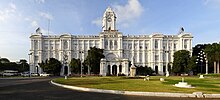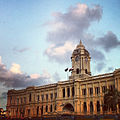
Marina Beach, or simply the Marina, is a natural urban beach in Chennai, Tamil Nadu, India, along the Bay of Bengal. The beach runs from near Fort St. George in the north to Foreshore Estate in the south, a distance of 6.0 km (3.7 mi), making it the second longest urban beach in the world, after Cox's Bazar Beach. It is a prominent landmark in Chennai.
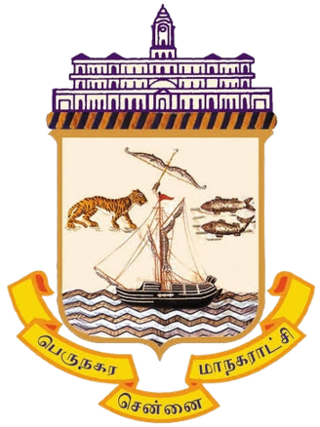
Greater Chennai Corporation (GCC) is a local government for the City of Chennai in the Chennai Metropolitan Area of Tamil Nadu, India. Inaugurated on 29 September 1688, under a royal charter issued by King James II of England on 30 December 1687 as the Corporation of Madras, it is the oldest municipal body of the Commonwealth of Nations outside Great Britain. It is the largest municipal corporation in Tamil Nadu with an area of 426 km2. It is headed by a mayor, who presides over 200 councillors, each of whom represents one of the 200 wards of the city. It is the second oldest corporation in the world after the City of London. The city limits, which had been expanded several times over the years, is currently coterminous with the Chennai district. It is one of the four municipal corporations located within the Chennai Metropolitan Area, the other three being the Tambaram Corporation, Avadi City Municipal Corporation and Kanchipuram Municipal Corporation.

TIDEL Park is an information technology (IT) park situated in the city of Chennai, India. The name TIDEL is a portmanteau of TIDCO and ELCOT. An ISO 9001/14001 company, In 2000, it was one of the largest IT parks in India. It was set up in 2000 to foster the growth of information technology in the state of Tamil Nadu by the TIDEL Park Ltd, a joint venture of TIDCO and ELCOT.

Chennai Mofussil Bus Terminus, officially Puratchi Thalaivar Dr. M.G.R. Bus Terminus, is a bus terminus located in Chennai, India, providing inter-state bus transport services. It is located on the 100 feet (30 m) Jawaharlal Nehru Salai in Koyambedu between SAF Games Village and the Koyambedu Vegetable Market. It is the second largest bus terminus in India as well as Asia. Chennai Metro Rail has operated a coach depot behind the bus terminus since 2015.
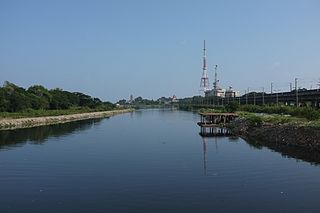
The Cooum river, or simply Koovam, is one of the shortest classified rivers draining into the Bay of Bengal. This river is about 72 km (45 mi) in length, flowing 32 km (20 mi) in the city of Chennai and the rest in rural part. The river is highly polluted in the urban area (Chennai). Along with the Adyar River running parallel to the south and the Kosasthalaiyar River, the river trifurcates the city of Chennai and separates Northern Chennai from Central Chennai. It is also sometimes known as Thiruvallikenni river

Panagal Park is a park and a locality in Thyagaraya Nagar, Chennai. The park is named after the Raja of Panagal, the Chief Minister of Madras Presidency who created the park. It is an important junction and is the commercial centre of T. Nagar.

Tholkappia Poonga or Adyar Eco Park is an ecological park set up by the Government of Tamil Nadu in the Adyar estuary area of Chennai, India. According to the government, the project, conceived based on the master plan for the restoration of the vegetation of the freshwater ecosystems of the Coromandel Coast, especially the fragile ecosystem of the Adyar estuary and creek, was expected to cost around ₹ 1,000 million which will include the beautification of 358 acres of land. The park's ecosystem consists of tropical dense evergreen forest, predominantly comprising trees and shrubs that have thick dark green foliage throughout the year, with over 160 woody species, and comprises six vegetative elements such as trees, shrubs, lianas, epiphytes, herbs and tuberous species. The park was opened to public by Chief Minister M. Karunanidhi on 22 January 2011 and named after the renowned Tamil scholar Tholkappiar. About 65 percent of the park is covered by water and artefacts and signages. In the first 2 months of its inauguration, nearly 4,000 children from several schools in the city and the nearby Kancheepuram and Tiruvallur districts have visited the park to learn about wetland conservation, eco-restoration and water management. While the first phase of the ecopark covered about 4.16 acres of CRZ-III area, the entire area covered under the second phase falls under this category.

Victoria Public Hall, or the Town Hall, is a historical building in Chennai, named after Victoria, Empress of India. It is one of the finest examples of British architecture in Chennai and was built to commemorate the Golden Jubilee of Queen Victoria. In the late 19th and early 20th centuries, it was used as a theater and a place for public gatherings. The South Indian Athletic Association Club now resides there.

George Town is a neighbourhood in Chennai, Tamil Nadu, India. It is near the Fort Saint George, Chennai. It is also known as Muthialpet and Parry's corner. It is an historical area of Chennai city from where its expansion began in the 1640s. It extends from the Bay of Bengal in the east to Park town on the west. The Fort St. George is on the south, to Royapuram in the north. The Fort St. George houses the Tamil Nadu Legislative Assembly and the Secretariat. The High court of Tamil Nadu at Chennai, Dr. Ambedkar Law College, Stanley Medical College and Hospital are located here.

The ITC Grand Chola is a 5-star luxury hotel in Chennai, India. It is located in Guindy, opposite SPIC building and along the same row of buildings as Ashok Leyland Towers. The building, designed by Singapore-based SRSS Architects, is of mixed-use development with three separate wings and is themed after traditional Dravidian architecture of the Chola dynasty. The hotel is the ninth hotel in The Luxury Collection brand.
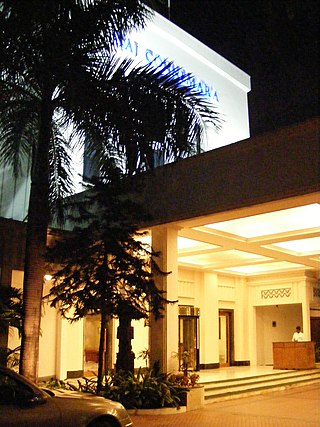
Taj Connemara, Chennai is a five-star hotel in Chennai, India. It is a heritage hotel in Chennai. Classified under the Taj Group's business hotels section, the 127-year-old hotel is considered the oldest hotel in the city.

P.Orr & Sons, founded in 1846, is a chain of stores that sells watches and clocks based in the city of Chennai in India. It used to primarily make clocks. It was started by Peter Orr from Scotland in 1846 on the foundation of the nascent George Gordon & Co.
Chennai, with historically rich records dating at least from the time of the Pallavas, houses 2,467 heritage buildings within its metropolitan area (CMA), the highest within any metropolitan area limit in India. Most of these buildings are around 200 years old and older. Chennai is home to the second largest collection of heritage buildings in the country, after Kolkata. The official list of heritage buildings was compiled by the Justice E. Padmanabhan committee. The Tamil Nadu Assembly passed the Heritage Commission Act in 2012 to preserve old heritage structures.
Tamil Nadu Government Dental College, also known as Government Dental Hospital and College, is the dental wing of the Madras Medical College. Although the college is a separate entity administratively, it is functionally integrated with the Madras Medical College and Government General Hospital.
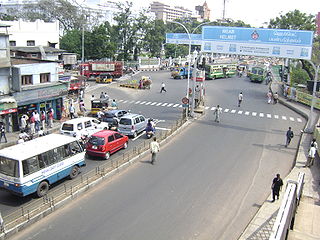
EVR Periyar Salai (EVR High Road), earlier known as Poonamallee High Road(NH 48) and originally the Grand Western Trunk Road, is an arterial road in Chennai, India. It is the longest road in Chennai. Running from east to west, the 14-kilometre (8.7 mi) road starts at Muthuswamy Bridge near Madras Medical College at Park Town and ends near Maduravoyal Junction via Kilpauk, Aminjikarai, Anna Nagar Arch, Arumbakkam, Koyambedu. It further continues west towards Poonamallee and traverses Sriperumbudur, Walajapet, and Ranipet.
Namakkal Kavignar Maligai is an 11-storied building at the Fort St. George campus in Chennai, India, serving as the power centre of state secretariat of Tamil Nadu. It is the only skyscraper built within the Fort campus. As of 2014, there were about 6,000 staff at the secretariat.

The Central Square is a city square and major intersection in Chennai. Areas surrounding the Ripon Building, Victoria Public Hall, Moore Market Complex, Chennai Central Railway Station, the Southern Railway Headquarters and the Government General Hospital are being developed as part of the Central Square. The total site area is estimated to be about 37,800 square meters, and the development is estimated to cost about ₹4 billion (US$50 million) and will be funded by the CMDA.
Shanti Theatre was an Indian movie theatre located in Chennai, Tamil Nadu. Built by G. Umapathy and D. Shanmuga Raja, and inaugurated in January 1961, it was bought by actor Sivaji Ganesan, and was owned by his family since. In May 2016, Shanti ceased screening films, and was re-invented by its owners as an Office space.

Chennai Central Metro, officially known as Puratchi Thalaivar Dr. M.G. Ramachandran Central metro station, is an underground metro station on the North-South Corridor of the Blue Line and Green Line of Chennai Metro in Chennai, India. Central metro station is spread over an area of 30,000 square metres (320,000 sq ft). On 31 July 2020, It has been named by Government of Tamil Nadu as Puratchi Thalaivar Dr. M.G. Ramachandran Central Metro to honor the All India Anna Dravida Munnetra Kazhagam founder and the former Chief Minister of Tamil Nadu M. G. Ramachandran.

Royapettah is a neighbourhood of Chennai, India.


